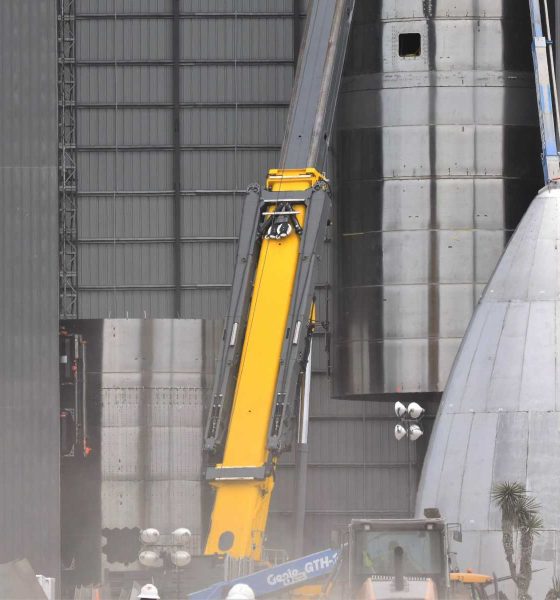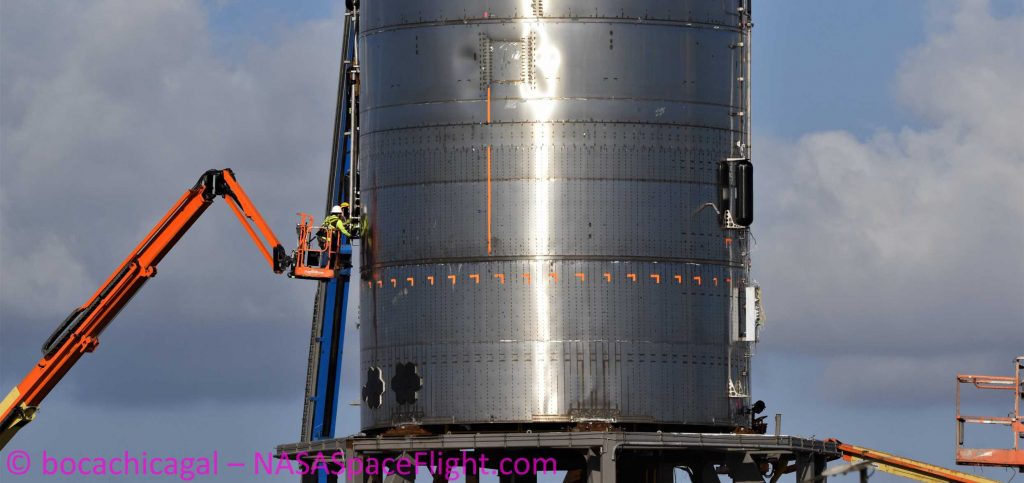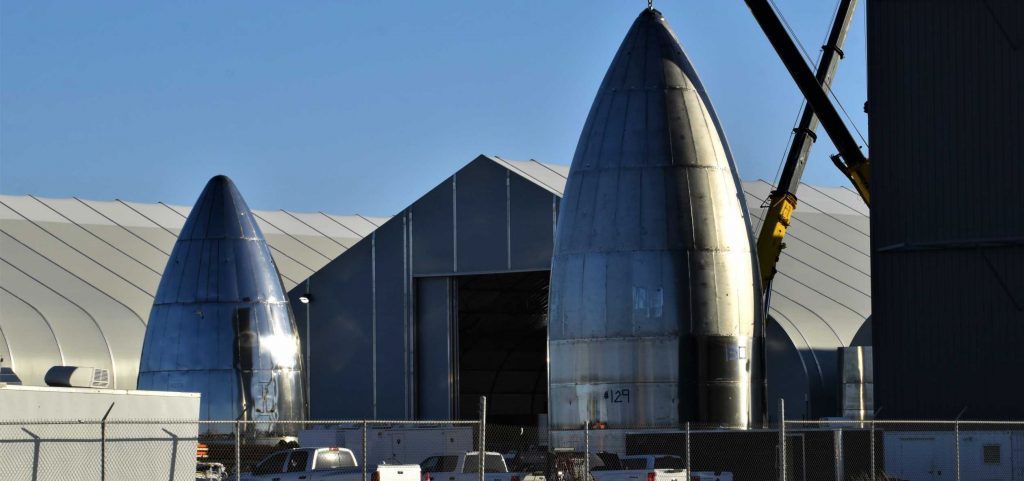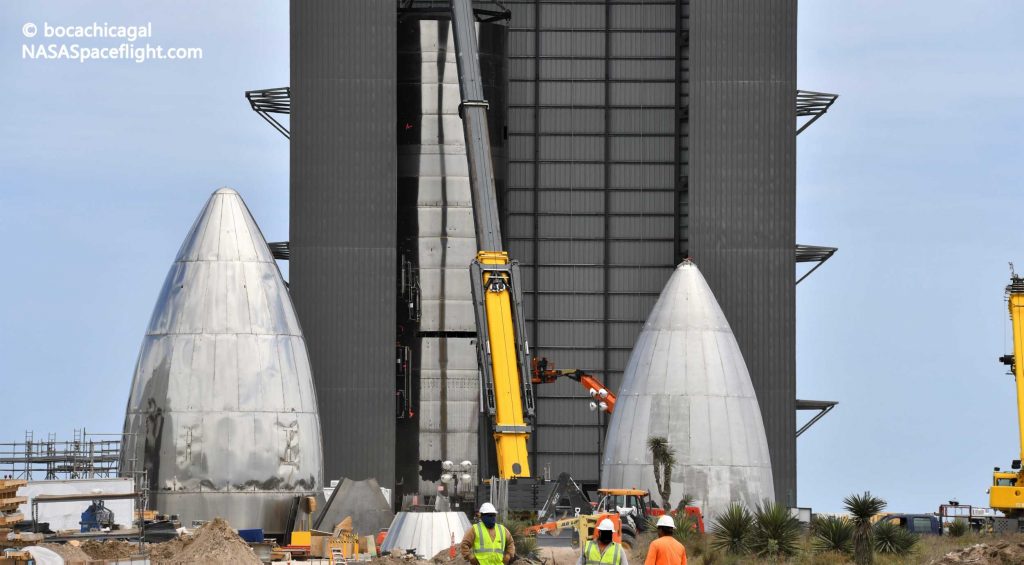

News
SpaceX is about to have a fleet of Starship rockets
SpaceX has finished the last major stacking event for the business half of its fifth full-scale Starship prototype, meaning that the company may be a week or less from having a fleet of Starships for the first time ever.
As of now, Starship serial number 5 (SN5) is on track to be completed in under a month, continuing a trend that SpaceX has managed over the entirety of 2020. Beginning in mid-January, SpaceX has completed several nosecone pathfinders, three test tanks, and three full-scale Starship prototypes – soon to be four once SN5 is finished. Once it is, however, SpaceX will be entering a new era of operations – fleet operations.
Up to this point, every full-scale Starship prototype and test tank SpaceX has built – excluding the tank SN2 was turned into in March – has been quickly destroyed over the course of one or two tests. For better or for worse, this has meant that SpaceX’s test and launch pad has always been more or less self-clearing, making way for the next prototype to roll out and begin testing after the scraps of its predecessor were removed. This time around, barring Starship SN4’s imminent demise, SpaceX will now have to deal with multiple completed Starship prototypes at the same time – a tiny taste of things to come.

For unknown reasons, SpaceX decided to swap out Starship SN4’s lone Raptor engine (likely SN18) after multiple wet dress rehearsals, partial engine tests, and two static fire tests – at least one of which was confirmed a success by CEO Elon Musk. Most recently, SpaceX removed Raptor SN18 to perform a more ambitious cryogenic pressure test, pushing Starship SN4’s propellant tanks all the way to 7.5 bar (~110 psi) at the same time as hydraulic rams simulated the thrust of three Raptor engines at the rocket’s base.
Instead of reinstalling Raptor SN18, SpaceX transported Raptor SN20 to the launch pad and installed it on Starship SN4 on May 10th, less than 24 hours after the prototype passed an orbital-class pressure test.


Aside from installing Raptor SN20, SpaceX teams have spent the last few days adding new COPVs (composite overwrapped pressure vessels) and plumbing to Starship SN4’s exterior – purpose largely unknown. While the new hardware is mostly a mystery, it is known that SpaceX is in the process of preparing SN4 and its new Raptor engine for a third wet dress rehearsal (WDR) and static fire test, necessary to ensure that Raptor SN20 is properly installed and functioning as expected.
Assuming that third static fire is successful, SpaceX’s will prepare Starship SN4 for its first flight, a ~150m (500 ft) hop test that will also be the first intentional flight of any full-scale Starship prototype since the program’s birth. For that hop test, SN4 will need some kind of attitude control system (ACS) thrusters to control its rotation and provide fine trajectory tuning to assist the ship’s lone Raptor engine. This is the likeliest explanation for the new hardware being installed on Starship SN4, as the ship does not currently appear to have ACS thrusters installed.
Starship Troopers
Of course, the first flight of a full-scale Starship prototype will probably be the riskiest test yet for the program and there’s a good chance that SN4 will meet its demise at some point during that flight. Enter Starship SN5.


As of May 12th, Starship SN5’s final two tank sections were stacked, effectively completing the most important half of the rocket (minus one final circumferential ring weld). SN5’s final outfitting of avionics and plumbing is still pending and will take at least a few days to a week or more, but that work can and has been completed after prototypes are transferred by road to the launch pad. Currently, Starship SN4 is occupying SpaceX’s one and only pad test stand, however, meaning that it wouldn’t make much sense to immediately move SN5 to the launch pad – at least until SN4 is done testing.
SN5 will also need a nose section and, perhaps, flaps installed, meaning that the full ship is likely still at least a week or two away from being finished, but that likely wont stop SpaceX from proof testing the rocket’s tanks if or when SN4 makes space at the launch pad.

According to comments made by Elon Musk, SN5 will likely become the first Starship prototype to have three Raptor engines installed and the first to attempt a truly high-altitude flight test if Starship SN4 is met with success in the coming weeks. As absurd as it feels to say, if SN5 completes triple-Raptor testing and a 20 km (~12 mi) flight test without issue, Musk has stated that the next step would be orbital flight tests. Starship SN6’s steel rings, meanwhile, are already being formed and stacked as SN5 nears completion.

Elon Musk
Elon Musk’s X will start using a Tesla-like software update strategy
The initiative seems designed to accelerate updates to the social media platform, while maintaining maximum transparency.

Elon Musk’s social media platform X will adopt a Tesla-esque approach to software updates for its algorithm.
The initiative seems designed to accelerate updates to the social media platform, while maintaining maximum transparency.
X’s updates to its updates
As per Musk in a post on X, the social media company will be making a new algorithm to determine what organic and advertising posts are recommended to users. These updates would then be repeated every four weeks.
“We will make the new 𝕏 algorithm, including all code used to determine what organic and advertising posts are recommended to users, open source in 7 days. This will be repeated every 4 weeks, with comprehensive developer notes, to help you understand what changed,” Musk wrote in his post.
The initiative somewhat mirrors Tesla’s over-the-air update model, where vehicle software is regularly refined and pushed to users with detailed release notes. This should allow users to better understand the details of X’s every update and foster a healthy feedback loop for the social media platform.
xAI and X
X, formerly Twitter, has been acquired by Elon Musk’s artificial intelligence startup, xAI last year. Since then, xAI has seen a rapid rise in valuation. Following the company’s the company’s upsized $20 billion Series E funding round, estimates now suggest that xAI is worth tens about $230 to $235 billion. That’s several times larger than Tesla when Elon Musk received his controversial 2018 CEO Performance Award.
As per xAI, the Series E funding round attracted a diverse group of investors, including Valor Equity Partners, Stepstone Group, Fidelity Management & Research Company, Qatar Investment Authority, MGX, and Baron Capital Group, among others. Strategic partners NVIDIA and Cisco Investments also continued support for building the world’s largest GPU clusters.
News
Tesla FSD Supervised wins MotorTrend’s Best Driver Assistance Award
The decision marks a notable reversal for the publication from prior years, with judges citing major real-world improvements that pushed Tesla’s latest FSD software ahead of every competing ADAS system.

Tesla’s Full Self-Driving (Supervised) system has been named the best driver-assistance technology on the market, earning top honors at the 2026 MotorTrend Best Tech Awards.
The decision marks a notable reversal for the publication from prior years, with judges citing major real-world improvements that pushed Tesla’s latest FSD software ahead of every competing ADAS system. And it wasn’t even close.
MotorTrend reverses course
MotorTrend awarded Tesla FSD (Supervised) its 2026 Best Tech Driver Assistance title after extensive testing of the latest v14 software. The publication acknowledged that it had previously criticized earlier versions of FSD for erratic behavior and near-miss incidents, ultimately favoring rivals such as GM’s Super Cruise in earlier evaluations.
According to MotorTrend, the newest iteration of FSD resolved many of those shortcomings. Testers said v14 showed far smoother behavior in complex urban scenarios, including unprotected left turns, traffic circles, emergency vehicles, and dense city streets. While the system still requires constant driver supervision, judges concluded that no other advanced driver-assistance system currently matches its breadth of capability.
Unlike rival systems that rely on combinations of cameras, radar, lidar, and mapped highways, Tesla’s FSD operates using a camera-only approach and is capable of driving on city streets, rural roads, and freeways. MotorTrend stated that pure utility, the ability to handle nearly all road types, ultimately separated FSD from competitors like Ford BlueCruise, GM Super Cruise, and BMW’s Highway Assistant.
High cost and high capability
MotorTrend also addressed FSD’s pricing, which remains significantly higher than rival systems. Tesla currently charges $8,000 for a one-time purchase or $99 per month for a subscription, compared with far lower upfront and subscription costs from other automakers. The publication noted that the premium is justified given FSD’s unmatched scope and continuous software evolution.
Safety remained a central focus of the evaluation. While testers reported collision-free operation over thousands of miles, they noted ongoing concerns around FSD’s configurable driving modes, including options that allow aggressive driving and speeds beyond posted limits. MotorTrend emphasized that, like all Level 2 systems, FSD still depends on a fully attentive human driver at all times.
Despite those caveats, the publication concluded that Tesla’s rapid software progress fundamentally reshaped the competitive landscape. For drivers seeking the most capable hands-on driver-assistance system available today, MotorTrend concluded Tesla FSD (Supervised) now stands alone at the top.
News
Elon Musk’s Grokipedia surges to 5.6M articles, almost 79% of English Wikipedia
The explosive growth marks a major milestone for the AI-powered online encyclopedia, which was launched by Elon Musk’s xAI just months ago.

Elon Musk’s Grokipedia has grown to an impressive 5,615,201 articles as of today, closing in on 79% of the English Wikipedia’s current total of 7,119,376 articles.
The explosive growth marks a major milestone for the AI-powered online encyclopedia, which was launched by Elon Musk’s xAI just months ago. Needless to say, it would only be a matter of time before Grokipedia exceeds English Wikipedia in sheer volume.
Grokipedia’s rapid growth
xAI’s vision for Grokipedia emphasizes neutrality, while Grok’s reasoning capabilities allow for fast drafting and fact-checking. When Elon Musk announced the initiative in late September 2025, he noted that Grokipedia would be an improvement to Wikipedia because it would be designed to avoid bias.
At the time, Musk noted that Grokipedia “is a necessary step towards the xAI goal of understanding the Universe.”
Grokipedia was launched in late October, and while xAI was careful to list it only as Version 0.1 at the time, the online encyclopedia immediately earned praise. Wikipedia co-founder Larry Sanger highlighted the project’s innovative approach, noting how it leverages AI to fill knowledge gaps and enable rapid updates. Netizens also observed how Grokipedia tends to present articles in a more objective manner compared to Wikipedia, which is edited by humans.
Elon Musk’s ambitious plans
With 5,615,201 total articles, Grokipedia has now grown to almost 79% of English Wikipedia’s article base. This is incredibly quick, though Grokipedia remains text-only for now. xAI, for its part, has now updated the online encyclopedia’s iteration to v0.2.
Elon Musk has shared bold ideas for Grokipedia, including sending a record of the entire knowledge base to space as part of xAI’s mission to preserve and expand human understanding. At some point, Musk stated that Grokipedia will be renamed to Encyclopedia Galactica, and it will be sent to the cosmos.
“When Grokipedia is good enough (long way to go), we will change the name to Encyclopedia Galactica. It will be an open source distillation of all knowledge, including audio, images and video. Join xAI to help build the sci-fi version of the Library of Alexandria!” Musk wrote, adding in a later post that “Copies will be etched in stone and sent to the Moon, Mars and beyond. This time, it will not be lost.”








